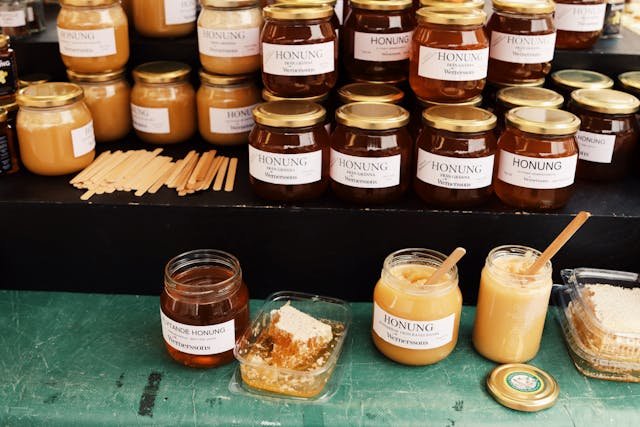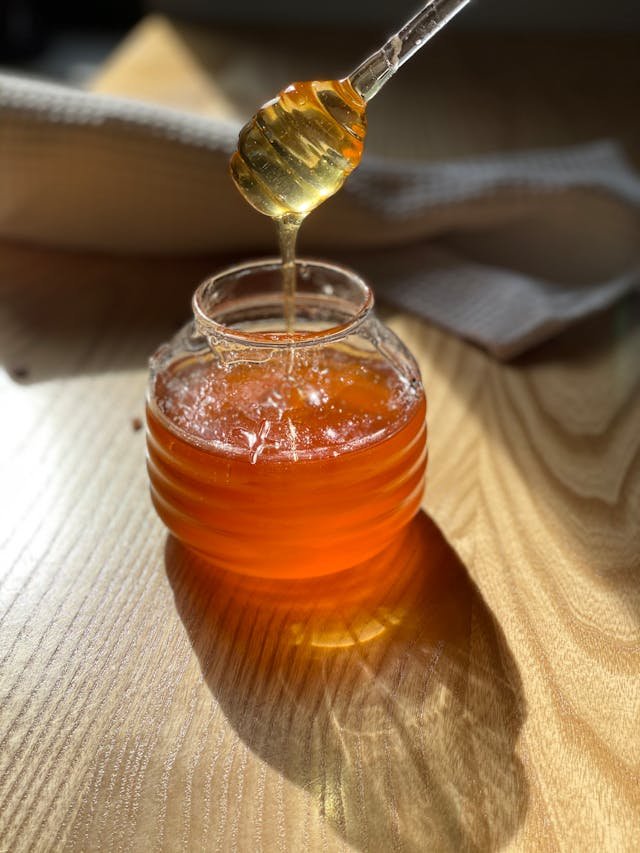Honey is not just honey. Each jar tells a story of the flowers that bees visited, the landscapes they explored, and the unique flavors they created. When it comes to European honey, the diversity is astonishing. Imagine the essence of a sunny lavender field in France, the rich flavors of a chestnut forest in Italy, or the floral notes of an alpine meadow in Switzerland. Imagine all of this through the taste of a single spoonful of European honey. European honey is much more than a sweet treat; it is a journey of flavor through the landscapes and blooms of the continent.
In my previous article, Exploring Global Honey we have already explored honey worldwide. Now, in this article, we will explore some of the most delightful European honey varieties. From the aromatic thyme honey of Greece to the refreshing linden honey of Germany, you will discover the unique tastes and stories behind each type. We will also share how to use these honeys in your kitchen, whether you are adding a touch of sweetness to your tea or enhancing the flavor of your favorite dishes.
So, whether you are a food lover, a honey enthusiast, or just curious about the different flavors of Europe, join us on this sweet adventure. Let us dive into the world of European honey and uncover the magic behind every jar!
The Sweet Symphony of European Honey
A Brief Overview of Honey’s Journey
Honey’s journey begins with the humble honeybee. These industrious insects collect nectar from flowers, which they then convert into honey through a process of regurgitation and evaporation. The type of flowers that bees visit significantly impacts the flavor, color, and texture of the honey they produce. This is why honey from different regions—and even different seasons—can vary so dramatically.
Why European Honey is Special
Europe’s diverse climates and landscapes make it a paradise for beekeeping. From the Mediterranean coasts to the mountainous Alps, each region offers unique floral sources that contribute to the distinctive characteristics of their honey. Moreover, traditional beekeeping practices, often passed down through generations, play a crucial role in maintaining the quality and authenticity of European honey.
The Variety of European Honey
French Lavender Honey: A Taste of Provence
Most likely, if you think of lavender fields, then you will be reminded of Provence. This is the area in Southern France that is famous for its housing of lavender fields and the region from which the special lavender honey was born.
Characteristics of Lavender Honey
- Flavor: Light and floral with a of soft sweetness taste.
- Color: Pale gold.
- Texture: Thin and velvet.
The mild flavor of the lavender honey gives a sense of the wonderful lavender flowers. It is the ideal thing to put as a draught on various types of food and drink.
Italian Chestnut Honey: Rich and Robust
This country’s ecosystem is very diverse and has a lot of activities related to the chestnut trees in the mountainous regions of such as ancient Tuscany and Piedmont. The chestnut honey mirrors the forests with such unique growings.
Characteristics of Chestnut Honey
- Flavor: Striking, excellent caramel overload.
- Color: Caramel in color.
- Texture: Not very dense and perfect for use as a spread.
Its strong flavor and lingering taste are what make it a favorite among those who prefer cheeses and strong dishes. People who enjoy a heavier/harder honey experience are gravitating towards it.
Greek Thyme Honey: The Essence of the Mediterranean
We know that Baba flowers of Greece are the honeybees’ greatest governing bodies providing the excellent quality of thyme honey. This particular honey is very common in Greek cuisine and is therefore often used in particular dishes.
Characteristics of Thyme Honey
- Flavor: Aromatic, with herbal and slightly peppery notes.
- Color: Light amber.
- Texture: Smooth and runny.
Thyme honey has a unique flavor. It is great in marinades, dressings, and drizzled over Greek yogurt.
Spanish Orange Blossom Honey: Citrus Delight.
Spain’s orange orchards are perfect for it. This honey captures the essence of springtime in the Spanish countryside.
Characteristics of Orange Blossom Honey
- Flavor: Sweet with a sign of citrus.
- Color: Light golden.
- Texture: Smooth and slightly viscous.
Orange blossom honey adds a sweet touch to drinks, baked goods, and breakfast dishes, like pancakes and waffles.
German Linden Honey: Floral Essence
Germany’s varied landscapes, especially Berlin, are perfect for linden honey. Characteristics of Linden Honey
- Flavor: Refreshingly minty with a hint of spiciness.
- Color: Light to medium amber.
- Texture: Smooth and runny.
German linden honey, especially from Berlin, has a unique taste. It goes well with herbal teas and can sweeten many dishes.
Alpine Meadow Honey: A Breath of Fresh Air
High in the European Alps, wildflowers bloom in untouched meadows. Bees produce alpine meadow honey there. This honey reflects the purity and diversity of its flower sources.
Characteristics of Alpine Meadow Honey
- Flavor: Floral, with a complex blend of wildflowers.
- Color: Varies from light to dark, depending on the flowers.
- Texture: Smooth and silky.
Alpine meadow honey is versatile. You can use it in many ways, from sweetening tea to enhancing baked goods.
The Art of Pairing Honey
Pairing honey with food can elevate your culinary experiences.
Here are some tips to enjoy European honey varieties:
Cheese and Honey: A Perfect Match Made in Heaven.
- Lavender Honey: It pairs well with brie and camembert.
- Chestnut Honey: Perfect with aged cheeses like pecorino or parmesan.
- Thyme Honey: Complements feta or goat cheese beautifully.
Honey in Baking
- Orange Blossom Honey: Ideal for cakes, cookies, and pastries.
- Alpine Meadow Honey: Adds a unique flavor to bread and muffins. Sweet and Savory Combinations
- Lavender Honey: Drizzle over roasted vegetables or grilled chicken.
- Chestnut Honey: Use in glazes for meats or add to hearty stews.
- Thyme Honey: Enhance salad dressings or marinades.
Conclusion
European honey varieties offer a tasty exploration of flavors. Each reflects the unique plants and traditions of its region. European honey adds a touch of its homeland to your table. Use it to drizzle French lavender honey over your morning yogurt. Or, try Italian chestnut honey in a savory dish. Next time you’re in the kitchen, grab a jar of European honey. Let it transport you to the beautiful landscapes where it was born. These honeys are a tasty journey across Europe, one spoonful at a time
Frequently Asked Questions (FAQ)
- What is the best way to store honey?
Honey should be stored in a cool, dry place, away from direct sunlight. It can crystallize over time, but this is a natural process and doesn’t affect its quality. If your honey crystallizes, put the jar in warm water. Stir until the crystals dissolve.
- How long does honey last? Honey lasts forever. Its low moisture and acidic pH stop bacteria. For the best flavor and texture, consume honey within two years of purchase.
- Can honey go bad? Honey doesn’t spoil, but its flavor and texture can change over time. If honey ferments or develops an off smell, it may be contaminated and should be discarded.
- Is European honey better than other types of honey? European honey isn’t better, but it has unique flavors. They reflect the continent’s diverse flora. Honey’s quality depends on the nectar source, beekeeping, and processing.
- How can I use honey in skincare? Honey is a natural humectant, making it great for moisturizing skin. You can use it as a face mask, mixed with yogurt or oats. Or, use it as a natural sweetener in homemade scrubs and lotions.



